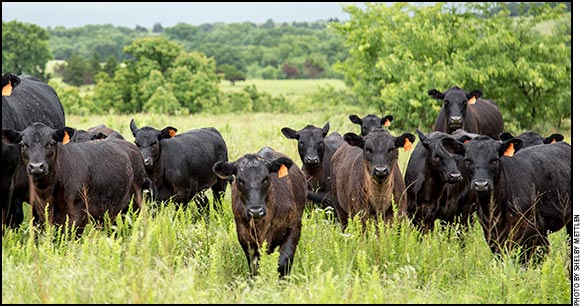HEALTH & NUTRITION...

Start Now
Now is the time to prepare for next spring’s calving season.
Only one to two months ago the spring-calving cows were calving, the temperatures were colder, and the calving pastures were covered with muck and manure. Experience would say that you do not want to ask cow-calf operators how calving is then, because the response would be less than objective, reflecting bone-chilling cold and not enough sleep.
If you wait too long, perhaps until this fall, time will have mellowed most of the events and one soon has difficulty matching a calving season with particular problems. Plus, it may be too late to make the necessary changes to reduce calving losses. Now is perhaps a better time to make a few notes on what to change for next year. Read more.
Make Treatment Plans a Priority
Treatment protocol plan a valuable management tool for cow-calf operations.
It is “calf-working time” in Oklahoma, which should serve as a valuable reminder for producers to get with their veterinarians to review, revise or — if one does not exist — develop a treatment protocol plan for their specific cattle operations.
Some may consider a treatment protocol plan as being something feedyards and larger stocker operations do; however, it is a valuable management practice for large and small cow-calf producers and a key part of the Beef Quality Assurance (BQA) program, remind animal agriculture professionals with the Oklahoma Cooperative Extension Service. Read more.
Preventing Summer Pneumonia
Good nutrition, management and well-timed vaccinations mean fewer outbreaks.
Every summer the signs are there — calves with an increased respiratory rate, gaunt calves that have been off feed, lone calves that are unwilling or unable to keep up with the group, calves with an ear down. It’s summer pneumonia, and about 10% of calves are afflicted each year. The disease is quite costly due to treatment costs, lost weight gains and, in some cases, death loss.
However, there is good news — summer pneumonia can be prevented. Check out these tips from Travis Van Anne, professional services veterinarian for Boehringer Ingelheim, to protect your herd. Read more.
Tips to Reduce and Handle Heat Stress in Livestock
Heat stress compromises animal health and performance.
Warmer temperatures are quickly approaching, and that means livestock producers should start considering how to help their animals handle the heat. Heat stress is almost inevitable, but some management practices can be implemented to help animals better cope with rising temperatures.
All mammals regulate their internal body temperature involuntarily. Heat stress occurs when the animal’s ability to self-regulate and lower core body temperature is overwhelmed and the animal’s performance and/or health is compromised. Read more.
Watch Out for Sneezeweed
Poisonous plant causes big problems for livestock in the Southern Plains.
One plant currently flowering across different parts of Texas is poisonous and should be of concern to ranchers, according to a Texas A&M AgriLife Extension Service expert.
Small-headed sneezeweed, which falls in the sunflower family, is a native, warm-season annual that grows statewide except for the East Texas Piney Woods and extends into northern Mexico, said Barron Rector, AgriLife Extension range specialist in College Station.
“Be aware that small-headed sneezeweed is very poisonous in the flowering stage to mainly sheep, but cattle, goats, mules and horses are also susceptible,” Rector said. Read more.
University to Host Disaster Prep Course
Animal resource exercise will help prepare for emergencies.
During natural disasters such as hurricanes, tornadoes, floods and winter storms, animals are especially vulnerable, and they rely on humans for help. The University of Kentucky (UK) College of Agriculture, Food and Environment (CAFE) is hosting the Multi-Jurisdictional Animal Resource Coordination Exercise (MARCE) 2017, a virtual exercise for animal responders across the United States. The exercise will take place July 11-12 and be repeated July 13-14. It will focus on disaster response for pets, livestock and horses, captive wildlife, and laboratory animals. Read more.
Making the Jump
The leg of the journey from replacement heifer to mature cow is critical.
As spring approaches, so does calving for most beef cattle producers. Spring also begins the most critical part of the journey for the replacement heifer in becoming a cow. A spring-calving replacement heifer with a target mature weight of 1,200 pounds (lb.) is likely weighing about 950 lb. entering the last trimester of pregnancy and would need to gain about 2.0 lb. per day prior to calving even if she were in a moderate body condition.
Producers need to remember that in the last trimester, at least half of that weight gain will be related to fetal growth and not actually contribute to the growth of the heifer herself. Read more.
Cattle Diseases: Common Conditions/Terms
Click here for a list of common conditions and terms related to beef cattle diseases, such as anaplasmosis, brucellosis, BVD, E. coli, IBR and others.
[Click here to go to the top of the page.]






